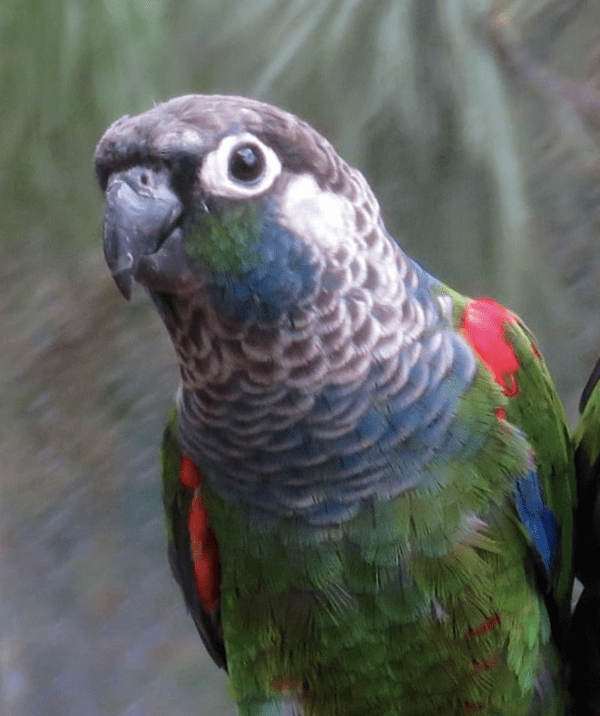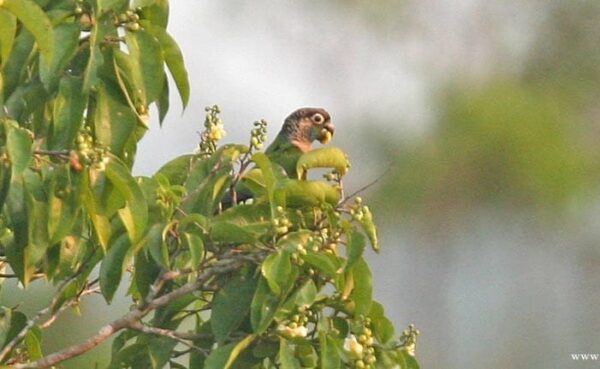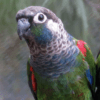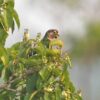Pearly Conure
Also known as:
Pearly Parakeet
Also known as:
Pearly Parakeet
DID YOU KNOW?
There are over 55 different species of conure. These are included in the genera Pyrrhura, Eupsittula, Enicognathus, Nandayus, Leptosittaca, Guaruba, Ognorhynchus and Cyanoliseus.

Pyrrhura

lepida
Size:
24 cm (9.3 in)
Weight:
70 g (2.4 oz)
Subspecies including nominate:
three: P.l. lepida, P.l. coerulescens, P.l. anerythra
Colour Adult:
P.l. lepida: Both adults blue collar on hindneck in varying thicknesses; brown cheeks, washed with dull blue; off-white ear coverts; brown breast, barred off-white and dark brown; red bend of wing and lesser underwing coverts; brown/red tail. Beak dark grey. Eye ring bare and off-white. Eye dark brown.
P.l. coerulescens: Both adults as in lepida, but with grey/brown breast and strong blue wash reaching up to throat.
P.l. anerythra: Both adults blue wash on breast absent; green bend of wing and underwing coverts have minimal or absence of red; varying red marks on green carpal edge.
Colour Juvenile:
P.l. lepida: Paler grey beak.
Call:
Calls made in flight are described as shrill. Other vocalisations not known.
More Information:
Content Sources:
BirdCare
CITES
BirdLife International
Cornell Lab of Ornithology/Birds of the World
Parrots: A Guide to Parrots of the World, Juniper and Parr, 1998
A Guide to Popular Conures as Pet and Aviary Birds, Dorge and Sibley, 2001.
Parrots of the World, Forshaw, 2006. 2010 editon
Parrots in Aviculture, Low, 1992.
Captive Status:
Uncommon in captivity.
Longevity:
20+ yrs.
Housing:
Aviary or suspended enclosure, minimum length 2 m (6.5 ft).
Diet:
Fruits such as: apple, pear, orange, pomegranates, cactus fruits, kiwi, forming about 30 percent of the diet; vegetables such as: carrot, celery, corn, green beans and peas in the pod; green leaves such as: Swiss chard, lettuce, sowthistle, dandelion, chickweed; spray millet; small seed mix such as: canary, millet and smaller amounts of oats, buckwheat, safflower and a little hemp; soaked and sprouted sunflower seed; cooked beans and pulses, boiled maize and complete kibble.
Enrichment:
Are active so provide a lot of toys, such as bird-safe, unsprayed flowering, fir, pine or willow branches, wooden toys, vegetable tanned leather toys, heat sterilized pine cones, puzzle/foraging toys, noise-makers, swings, ladders and ropes. Also provide misters and shallow bowls for bathing.
Nest Box Size:
Nest log or box 8″ x 8″ x 24-28″ (20.3 cm x 20.3 cm x 61-71 cm).
Clutch Size:
3-5
Fledging Age:
7-8 weeks
Hatch Weight:
—
Peak Weight:
—
Weaning Weight:
—
World Population:
Unknown, rapidly decreasing.
IUCN Red List Status:
Vulnerable
CITES Listing:
Appendix II
Threat Summary:
Habitat loss has greatly impacted the species, but it appears more tolerant of disturbed habitats. Trapping for trade may be a more important factor in decline than previously assumed. Is known from several protected areas, including the Serra dos Carajas mosaic of conservation units, but some of these are threatened by illegal logging. This species is expected to lose 34-35% of suitable habitat in its range over three generations.
Range:
P.l. lepida: NE Para, east to NW Maranhao, Brazil.
P.l. coerulescens: E and C Maranhao.
P.l. anerythra: E Para.
Habitat:
Found up to 500 m (1640 ft) in lowland terra firme tropical rainforest. Also has been reported from forest edge, clearings and secondary growth.
Wild Diet:
Diet includes fruits of Trema micrantha (Ulmaceae) and Didymopanax morototonii (Araliaceae). Also seen feeding on Erythrina (Fabaceae).
Ecology and Behaviour:
Are noisy and conspicuous while in flight, but well hidden while resting in upper stages of canopy. Seen in flocks of up to ten birds, particularly at good food source.
Clutch and Egg Size:
3-5 eggs, 26.0 x 21.0 mm (1 x 0.8 in).
Breeding Season:
Probably August-November.
Related Links:
—




![© manginwu [CC BY-SA 2.0] via Wikimedia Commons A companion Pearly Conure perches on a plastic stand](https://parrots.org/wp-content/uploads/2023/01/wpt_Pearly-Conure_1336-2-100x100.jpg)
